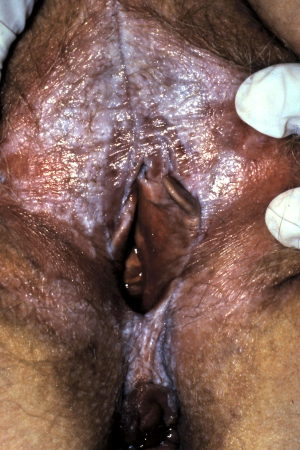Summary
Definition
History and exam
Key diagnostic factors
- changes in skin colour and/or texture
- purpura and/or ecchymoses
- pruritus
- sclerosis/scarring and/or loss of normal anatomical structures
- dyspareunia and/or sexual dysfunction
- fissures
Other diagnostic factors
- skin irritation and/or discomfort and/or pain
- uncircumcised state
- erosions
- excoriations
- Koebnerisation
- urinary dribbling and/or incontinence
- dysuria
- lichenification and/or hyperkeratosis
- painful defecation
- constipation
- anogenital and/or vulval bleeding
- changes in urinary stream
- lesions of the oral cavity and/or lips
Risk factors
- family history
- uncircumcised state
- urinary incontinence (in men/boys)
- female sex
Diagnostic investigations
Treatment algorithm
Contributors
Authors
Melissa Mauskar, MD, FAAD
Associate Professor
Department of Dermatology
Department of Obstetrics and Gynecology
UT Southwestern Medical Center
Dallas
TX
Disclosures
MM has received a grant from the Dermatology Foundation to study lichen sclerosus in postmenopausal women. MM has given lectures on lichen sclerosus.
Christina Kraus, MD, FAAD
Assistant Professor
Department of Dermatology
UC Irvine Health
Irvine
CA
Disclosures
CK is a recipient of the Dermatology Foundation Career Development Award and a consultant for Nuvig Therapeutics. CK has received consulting fees from LEO Pharma.
Peer reviewers
Libby (Irene Elizabeth) Edwards, MD
Director
Southeast Vulvar Clinic
Charlotte
NC
Disclosures
LE is co-author of the Genital Dermatology Manual, 1-4th edition, Wolters Kluwer, and a speaker for Symposium Medicus.
Fiona M. Lewis, MB BCh, MD, FRCP
Consultant Dermatologist
St John’s Institute of Dermatology
Guy’s & St Thomas’ Foundation Trust
London
UK
Disclosures
FML has received reimbursement for editing textbooks; has written national and international guidelines for the management of lichen sclerosus (the British Association of Dermatology, the International Union Against Sexually Transmitted Infections, and the British Association for Sexual Health and HIV); and has received reimbursement for lecturing on lichen sclerosus and vulval disease, but not from any commercial organisation or for endorsing any drugs.
Peer reviewer acknowledgements
BMJ Best Practice topics are updated on a rolling basis in line with developments in evidence and guidance. The peer reviewers listed here have reviewed the content at least once during the history of the topic.
Disclosures
Peer reviewer affiliations and disclosures pertain to the time of the review.
References
Key articles
Simms-Cendan J, Hoover K, Marathe K, et al. NASPAG clinical opinion: diagnosis and management of lichen sclerosis in pediatric and adolescent patients. J Pediatr Adolesc Gynecol. 2022 Apr;35(2):112-20. Abstract
van der Meijden WI, Boffa MJ, Ter Harmsel B, et al. 2021 European guideline for the management of vulval conditions. J Eur Acad Dermatol Venereol. 2022 Jul;36(7):952-72.Full text Abstract
Lewis FM, Tatnall FM, Velangi SS, et al. British Association of Dermatologists guidelines for the management of lichen sclerosus, 2018. Br J Dermatol. 2018 Apr;178(4):839-53.Full text Abstract
Kirtschig G, Kinberger M, Kreuter A, et al; European Dermatology Forum. EuroGuiDerm guideline on lichen sclerosus. Jun 2023 [internet publication].Full text
American College of Obstericians and Gynecologists. Diagnosis and management of vulvar skin disorders: ACOG practice bulletin summary, number 224. Obstet Gynecol. 2020 Jul;136(1):222-5. Abstract
Reference articles
A full list of sources referenced in this topic is available here.
Use of this content is subject to our disclaimer
